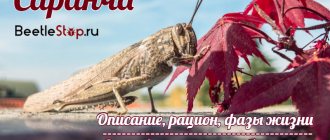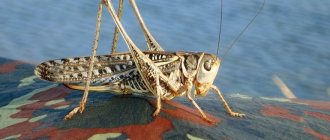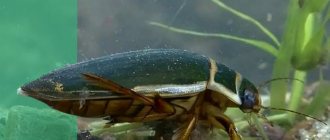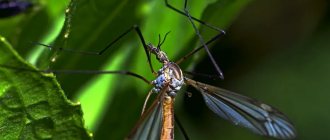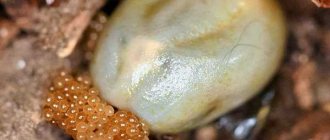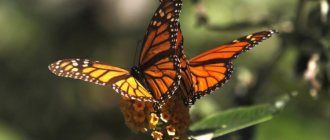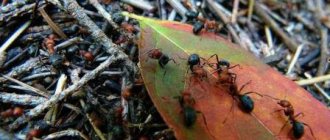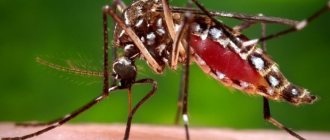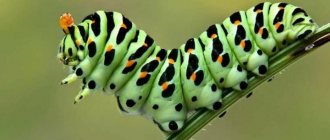Locusts appeared on the planet much earlier than humans. In ancient times, these pests were called the jaws of the wind. In ancient Greece, they prayed to the gods to avoid locust plagues. And these pests were feared like fire for a reason; today locusts are one of the most formidable enemies of agriculture.
The Asian locust is a gregarious insect belonging to a subspecies of migratory locust.
This type of pest lives in Central Asia, India, Afghanistan, Siberia, Mongolia, China and North Africa.
Species and man
Migratory locusts are a serious polyphagous pest.
During the years of mass reproduction and outbreaks of locust numbers, serious damage is caused to grain (wheat, rye, barley, oats, corn, rice, sorghum, millet), legumes (peas, beans, soybeans, alfalfa) crops, as well as hayfields and pastures.
The larvae and adults of migratory locusts provide high-quality, balanced food for many insectivorous animals. They are practically indispensable for keeping many species of small monkeys and prosimians, rodents, as well as terrarium animals (reptiles, amphibians and spiders).
Countermeasures
To prevent agricultural disasters, the number of insects at different stages of development of migratory locusts is monitored in breeding areas.
Such accounting makes it possible to predict the appearance of the gregarious form and apply insecticides in the phase of population growth, including barrier treatment of nesting sites.
The biological enemies of locusts are insectivorous mammals and birds (especially starlings), as well as some fungi that are pathogenic for orthopterans.
Agrotechnical prevention of the growth of the Asian locust population is:
- Drainage of floodplains of rivers and lakes using them for agricultural plantings.
- Improvement of pastures by mass sowing of forage grasses. The soil, densely entwined with roots, becomes unsuitable for laying eggs.
- Deep plowing of areas infested with locusts, with turning over of the earth layer and harrowing.
- Spring disc loosening along roadsides and slopes of irrigation canals.
Asian migratory locust (family name - locusts), type of development - indirect. During the period of mass reproduction, this pest poses a real threat to all agricultural crops.
The rise in the number of these insects can be prevented by agrotechnical and biological prevention, as well as timely treatment of breeding sites with insecticides.
Appearance
A large insect, body length ranges from 35 to 45 mm in males and from 45 to 55 mm in females. The antennae are short. Mandibles (jaws) are blue. The elytra are shiny with brown spots, distinctly longer than the abdomen. The wings are transparent with a faint yellowish-green tint and black veins. The body shape depends on whether the individual belongs to the gregarious or solitary phase. Individuals of the solitary phase have a pronotum without constrictions and a high, arched median carina in profile. In individuals of the gregarious phase, the pronotum is saddle-shaped with a clear constriction and with a straight or slightly concave median carina (in profile).
The color is usually green, brown, yellowish-green or gray, but can also vary depending on the phase.
Locusta migratoria L. (=L. danica L.; Pachytylus migratorius; P. danicus; Acridium migratorium) - Asian migratory locust
Systematic position.
Class Insecta, order Orthoptera, family Acrididae, subfamily Acridinae, tribe Locustini, genus Locusta. Within the former USSR there are two subspecies, including the nominative one. In the forest-steppes and in the south of the forest zone of European Russia, the subspecies L. migratoria rossica Uv. et Zol. (Central Russian locust).
Biological group.
Polyphagous harmful insects.
Morphology and biology.
Large insect: body length of males is 35-50, females - 45-55 mm. The forehead is steep. Mandibles are blue. Pronotum without X-shaped pattern. The elytra are long, shiny, length in males - 43.5-56.0, females - 49.0-61.0 mm. The wings are colorless, without bandages. The hind femora are bluish-black inside in the main part. The length of the hind femur in males is 22.0-26.0 mm, in females -20.0-32.0 mm. Hind tibia yellowish or red. The chest below is covered with dense short hairs forming a felt. The color can vary depending on the phase, usually green, brown, yellowish-green or gray. In individuals of the gregarious phase, the pronotum is saddle-shaped, with a clear constriction and a straight or slightly concave median carina (in profile). In individuals of the solitary phase it is without constriction and has a high, arched median keel in profile. The capsule is large, slightly curved, sometimes straight, slightly compressed from the sides, 50-85 mm long, 7-10 mm in diameter. It presents a column of foamy pinkish-white secretion in which the eggs are placed. The walls are soft, matte, brownish-pink, powdered with soil particles. Eggs in the amount of 40-120 pieces, thin, tapered at both ends, yellow in color, slightly shiny, 7-8 mm long, arranged in 4 longitudinal rows at an angle of 40-45° to the side walls. The secretion of the eggs does not hold it together; it rises above them in the form of a column 1/4-1/5 the size of the egg capsule. When laid, the upper edge of the egg capsule is at a depth of 5-8 mm from the soil surface. Egg capsules are deposited mainly in light, sandy soils. Larvae of 5 instars.
Spreading.
The range of migratory locusts includes almost all temperate and tropical regions of the Eastern Hemisphere. Its northern border in Eurasia approximately coincides with the southern border of the taiga zone. Former USSR: the middle zone and the south of the European part, the Caucasus, the south of Siberia to Primorye, Kazakhstan, Central Asia, the Kuril Islands (Kunashir Island).
Ecology.
It nests along the banks of rivers, lakes and seas, in reed thickets of Phragmites australis, forming large massifs - floodplains. There are 7 areas of permanent habitat, or nesting grounds, of the Asian locust in the former USSR, of which the Balkhash-Alakol and Amudarya nesting sites are currently functioning the most actively. In recent years, the Caspian and Dagestan outbreaks have also become more active. The hatching of larvae in most nests occurs in the middle or end of May. Hatching is amicable, on one fallow it ends in 4-5 days. Larval development lasts 35-40 days (i.e. 7-8 days for each instar). The larvae of the gregarious phase gather in bands from the first days after hatching. The maximum density of larvae in the swarms reaches 80,000 ind./m2 for larvae of the 1st instar and 7,000 ind./m2 for larvae of the 5th instar. Clusters of larvae can migrate over long distances: in sparse vegetation, 5th instar larvae travel up to 3 km per day. Adults appear in late June - early July. Approximately 10 days after fledging, mass flights of flocks begin. Mating begins 2-4 weeks after fledging, and after another 2-3 weeks (usually at the end of July) the females begin laying eggs. Each female lays 2-3, and in southern nests and in warm weather - up to 5 egg capsules, containing an average of 60-80 (maximum up to 120) eggs. In terms of its feeding regime, the Asian locust is a rather narrow oligophage, preferring cereals (reed, wheatgrass, reed grass). Accordingly, among cultivated plants it can severely damage grain crops, including rice. When flying outside their nests or when there is a lack of their favorite cereal food, the Asian locust feeds on a very wide range of plants belonging to several dozen families. Each individual eats from 300 to 500 g of green food during its life. The dynamics of Asian locust populations is closely related to changes in the water regime in their nesting areas: alternating seasonal floods and drying out of floodplains cause a reduction or expansion of the food supply and areas for oviposition.
Economic importance.
Larvae and adults of the gregarious phase (ph. gregaria) severely damage wheat, rye, barley, oats, corn, rice, millet, sorghum, alfalfa, peas, beans, beans, soybeans, clover and other legumes, table and sugar beets, potatoes, tobacco, poppy, cabbage, rutabaga, cucumbers, watermelons, melon and other pumpkins, sunflower, hemp, hops, buckwheat, marshmallow, cotton, flax, castor oil, vegetable and other crops, young plants of many fruit and forest species and shrubs, hayfields , pastures. Within the USSR, the habitats and occurrence of the gregarious phase of migratory locusts, from where they made periodic flights, were for a long time located in the deltas of the Danube and Dniester, in the lower reaches of rivers flowing into the east. part of Azov and northern. part of the Caspian Sea, along the middle reaches of the Syr Darya, in the Amu Darya delta, in the basin of Lake. Balkhash, in the lower reaches and middle reaches of the Irgiz, Turgai, Sarysu and Chu rivers, along the banks of lakes Alakol and Zaysan, but at present most of these foci, thanks to the successful and constant fight against this dangerous pest, have practically ceased to be places of mass hatchings of the gregarious phase , although they pose a constant threat, especially for outbreaks located in the lower reaches of the Volga, the Caspian lowland, in the Aral Sea region (the lower reaches of the Irgiz, Turgai, Chu, Syrdarya and Amu Darya rivers) and in the basin of lakes Balkhash, Alakol and Zaysan. Individuals of the single phase (ph. solitaria) of migratory locusts slightly damage various vegetable crops, rice, cotton and ether plantations in Tajikistan.
Spreading
Migratory locusts have the largest distribution area of any locust in the world. It includes almost all temperate and tropical parts of the eastern hemisphere, i.e. Europe, Africa, including Madagascar, the Arab and Indian subcontinents, the Caucasus, Central and Southeast Asia, Australia, Papua New Guinea and New Zealand.
In this vast territory, migratory locusts are divided into 7 subspecies, two of which—Central Russian and Asian migratory locusts—are found in Russia.
In Russia, migratory locusts are common in the Central Black Earth, Volga-Vyatka, North Caucasus, Volga and Ural regions. The main subspecies, the Asian locust, is distributed in the southern parts of its range, where there are permanent breeding centers among reed thickets along the shores of lakes and in the deltas of the Kuban, Terek and Sulak rivers. The second subspecies - the Central Russian locust - lives on the Central Russian Upland, in dry sandy, well-warmed areas in the middle reaches of the Volga and Oka.
Ways to fight
When an insect appears on a summer cottage, it is urgently necessary to protect it. The following methods for eliminating pests are available:
- chemical,
- burning,
- mechanical,
- digging.
Chemical method
Chemicals are effective in eliminating all types of insects.
Substances with poison should be used carefully, because they can make the crop harmful and sometimes fatal. The right time for processing is spring, before sowing begins.
The procedure is repeated during the peak of the locust invasion.
The advantage is less chemicals, since protection components will be present in the soil. Modern chemicals may not give positive results: adult individuals are resistant to various poisons. In such a situation an integrated approach , including preventive measures, spraying and mechanical extermination.
Mechanical method
The mechanical method of insect control is intended to destroy several adult insects, but will not help with their massive invasion. This method can only get rid of the larvae laid by locusts and located in damp soil at a shallow depth.
One of the most common pests of grain crops is the red-breasted leopard. The meadow borer can cause serious damage to your crops. Read about methods of combating meadow moth in this article.
To learn about the damage that the nutcracker can cause, read https://stopvreditel.ru/rastenij/selxoz/zhuk-shhelkun.html at this link.
Burning method
The method of dry burning cereal crops is considered controversial, since it helps to get rid of some of the locust egg clutch, which is located in the soil at a depth below 7 cm. The heat from the straw does not penetrate to this level.
Digging method
Digging up the area is aimed at finding and eliminating a large number of larvae, but this method will not completely destroy the pests. It is impossible to avoid the invasion of Asian locusts, but timely control will help prevent the reappearance of the parasites.
Protection measures must be carried out while the locust is in the larval stage, because upon transition to the adult phase it becomes resistant to the use of chemical poisons. Do not exclude spraying, which has recently become especially popular.
The following pesticides are used for it:
- "Fastak"
- "Fufanon"
- "Karbofos"
- "Sumition"
- "Decis Extra"
- "Sherpa"
- "Fury."
For low-volume spraying, 1 liter per hectare is taken, and for full-volume spraying, 200 liters per hectare.
Reproduction
The female lays eggs in the upper layers of the soil, digging it out with the end of her abdomen. Simultaneously with the laying of eggs, it secretes from the accessory glands a foamy liquid that quickly hardens in air, which cements the soil particles. This is how a capsule is formed. The egg capsule of the migratory locust is large, slightly curved, sometimes straight, slightly compressed from the sides, 50-85 mm long, 7-10 mm in diameter. It is a column of foamy pinkish-white secretion in which eggs are placed. The walls of the egg capsule are soft, matte, brown-pink.
Life cycle of the Asian locust
The pest overwinters in the egg stage in a capsule. In May, larvae emerge from the eggs in a white film; after a couple of hours they darken and begin to feed on vegetation. In its development, the larva goes through five instars, each of which differs in the degree of development of the wing primordia and in the number of segments on the antennae. The adult locust actively feeds and 30-40 days after mating, the female migratory locust begins to lay eggs. Each female lays on average three egg capsules (up to 350 eggs). The adult dies in October.
Migrations
The gregarious form forms dense aggregations of larvae, called bands, and adults (flocks), which live, feed and move together. During the years of mass reproduction, swarms of locusts can occupy huge areas (up to several thousand hectares) and travel long distances (up to 45 km), eating everything in their path. Imago locusts unite in swarms and can migrate over distances exceeding 200 - 300 km, and when caught by strong winds - more than 1000 km, flying far beyond the nesting grounds.
Control of Asian migratory locusts
To prevent a devastating summer in breeding areas, the development of the insect is monitored. This helps to prevent and predict the herd form in order to apply pesticides in time.
Natural enemies of the locust family are some insectivorous mammals and birds. The starling group is especially fond of the pest. From the plant world - a pathogenic fungus.
In order to prevent and suppress colony growth, agrotechnical methods are used:
- Drainage of reservoirs with the following use for sowing agricultural crops.
- Dense sowing of forage grass on pastures. Dense root braiding is not suitable for locusts to lay eggs.
- Deep plowing of locust lands, with turning out the soil layer and harrowing.
- Loosening roadsides with disks in the spring and slopes of irrigation systems.
It will take a lot of work to eradicate millions of Asian locust populations. But this is necessary, because otherwise the entire crop of cultivated plantings will be destroyed.
Life history of a species in a zoo
At the Moscow Zoo, migratory locusts are bred as food insects. The culture of migratory locusts has existed in the zoo since the mid-80s of the last century. On display, this species can be seen in the Birds and Butterflies pavilion at the Insectopia exhibition.
The main food for locusts are wheat seedlings 7–10 cm long, which are laid out at the bottom of the cages 2 times a day. Locusts do not need drinking water. Containers with peat are used for laying eggs. Each cage contains 300–500 adults or middle-aged larvae. Low content density stimulates the transition to a single phase, which is undesirable for mass content.
Text author: N.N. Vasyukova
Methods of protection against migratory locusts
Agrotechnical and organizational and economic control methods include autumn deep plowing, which will help get rid of the wintering form. It is also necessary to reduce possible egg-laying sites, that is, to develop virgin soil, improve forest belts, fight weeds not only in the field, but also beyond it, and get rid of plant residues.
It is also recommended to sow hundred-meter strips of industrial crops along the perimeter of the field; this will help protect the cereal crops from pest attacks.
Description and features
Nature has endowed the locust with an elongated body and six limbs, of which two pairs are short and weak, one (the back) is stronger and much longer. In some cases, there are specimens whose “height” approaches 15 cm.
This subspecies has a large head with clearly visible eyes. One pair of solid elytra covers 2 transparent wings, which are practically invisible when folded. Locusts belong to the long-existing order of Orthoptera, of which there are supposedly more than twenty thousand species.
Coloring usually has nothing to do with heredity; color is influenced only by the conditions in which the individual lives and the stage of its formation. Specimens coming from the same litter will be colored differently if they were raised in different conditions.
The stage of formation has a direct impact on how the insect looks - single insects are painted in camouflage shades (green-yellow or walnut), which are influenced by the region of residence. When a flock is formed, everyone acquires a color exactly the same as everyone else. Gender divisions are already disappearing at this time.
The speed at which the flock moves reaches 120 km per day. The locust in the photo looks like a grasshopper familiar to every child. In order not to make a mistake and not miss the appearance of a formidable dirty trick, you should pay attention to the following characteristic features:
- Locusts and grasshoppers are recognized primarily by the size of their antennae. The grasshopper's whiskers are not much larger than his own size, the locust has short whiskers, they are no more than his head;
- locusts have less developed forelimbs than grasshoppers;
- grasshoppers love the coolness of the night and begin to become active in the evening, and locusts are active during daylight hours;
- grasshoppers are loners, they never gather in large groups for self-preservation;
- the common grasshopper is a predator that eats only small insects, the locust is a plant eater (for the most part, it will indiscriminately eat everything it comes across).
